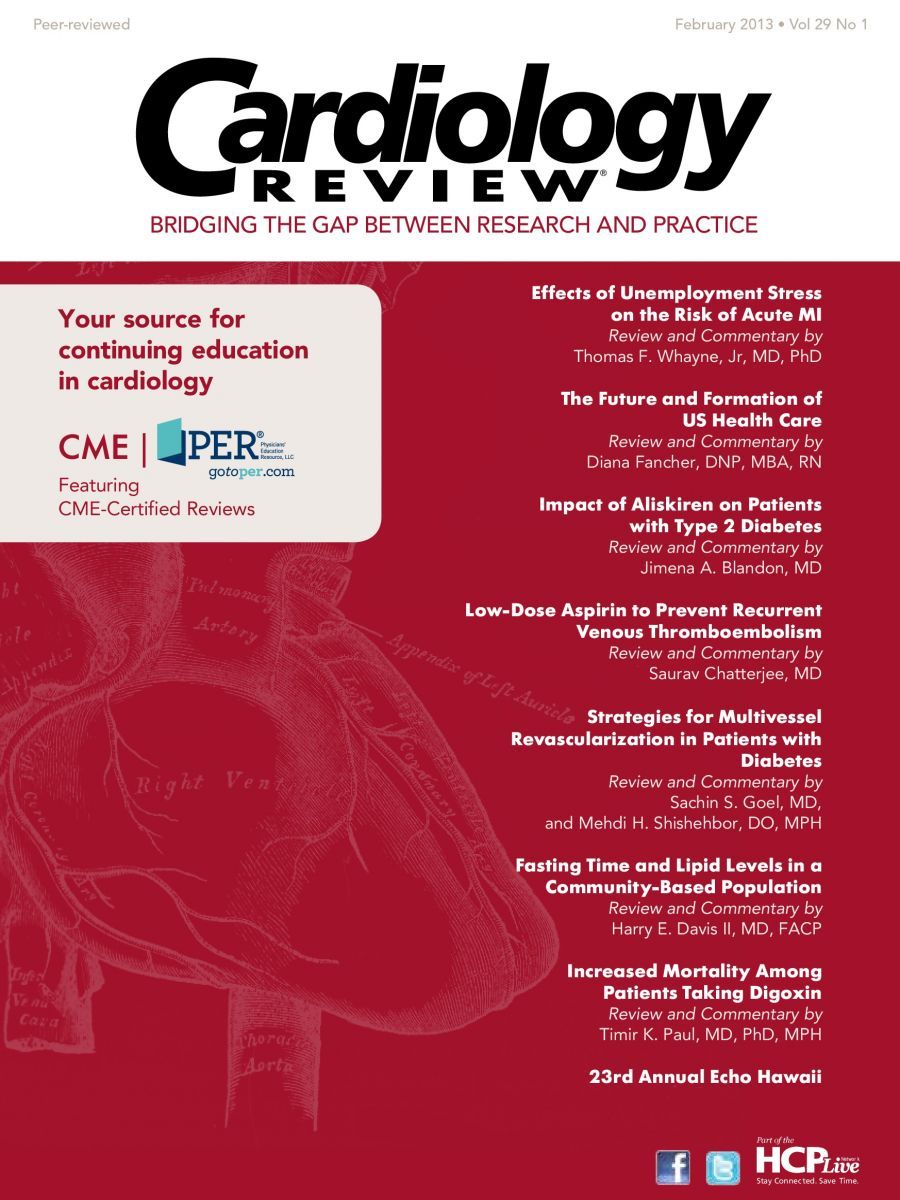The Future and Formation of US Health Care

Diana Fancher, DNP, MBA, RN
Review

In his recent commentary, “The Future of Obamacare,” published in the New England Journal of Medicine, Jonathan Oberlander, PhD, of the University of North Carolina, Chapel Hill, expresses his views on the imminent implementation of the Patient Protection and Affordable Care Act (ACA), passed in 2010 and upheld by the US Supreme Court in June 2012.1,2 Republicans have few or minimal options for repeal or derailment of the ACA after the November 2012 reelection of President Obama and the retention of majority Senate control by Democrats.
Dr. Oberlander points out that Republicans are left without viable options for overturning the ACA through legislative or executive action, as the earliest a Republican will potentially be in the White House is 2017, which is why the GOP considered the 2012 elections to be pivotal to the future and formation of US health care. The basic tenets of the ACA will have been implemented and in effect for 3 years by the time the next presidential election is held. It will be difficult to take health care benefits away from the public once they are actualized.
However, the Republicans have the option to target some politically vulnerable provisions in the ACA. Potential tactics to be used include derailment or disruption of the Medicare Independent Payment Advisory Board, and using leverage in budget negotiations to make changes such as cutting implementation funding and granting states more control. The ACA will now move forward, and disruptive tactics will not stop the implementation of the overall intent of the Act, but certain provisions will evolve into political gaming.
The current focus is on the individual states’ role in establishing health insurance exchanges (HIEs). The exchanges are regulated marketplaces in which the uninsured and small businesses will purchase coverage. In models of HIEs being proposed and implemented, there exist several options for the basic foundation and oversight of these groups, with many uncertainties mounting about the operations. The variations of oversight include state-run exchanges, federally run exchanges in states where the state refused to create HIEs, states partnering with the federal government, and several states that have not yet decided what to do.
Questions Oberlander poses in regard to the crafting of HIEs include:
• How ready will states be for the first enrollment period, currently slated to begin October 2013?
• How will the newly formed HIEs compete with well-established and dominant insurers already present in markets, and will the exchanges expand over time?
Initially HIEs will have a moderate reach, including uninsured and workers in small business, but by 2017 HIEs can enroll workers in larger firms, which will increase their scope and influence, in addition to states becoming eligible for innovation waivers, which will enable to them to create their own reform within federal guidelines.
The US Supreme Court’s June 2012 decision made the ACA’s Medicaid expansion optional for individual states, even though the federal government will initially pay 100% and eventually 90% of the costs for new enrollees. Many potentially eligible enrollees will remain without coverage in these states, leaving hospitals vulnerable as a future threat of decreased Medicare payments for treating a disproportionate share of the low income looms, without any prospect of offsetting these decreased payments.
There are continued challenges with the ACA, including an estimated 30 million Americans who will not have insurance, continued deeply divided public opinion, and inaccurate speculation regarding end-of-life decisions. The public opinion issue may be linked to an unclear identity without well-defined beneficiaries. In addition, the ACA attempts to fill in gaps related to the current insurance system, and contains a broad array of experiments in health care delivery and reimbursement. One of the biggest challenges is the cost. Eventually, the issue of forced cost containment will be in the forefront. As fiscal pressure gains momentum, the struggles between current Medicare, Medicaid, costs, financing, and insurance subsidies will determine future support, funding, and expansion of the ACA.
References
1. Oberlander J. The future of Obamacare. N Engl J Med. 2012;367;2165-2167.
2. The 2010 Patient Protection and Affordable Care Act [HR3590]. http://www.gpo.gov/fdsys/pkg/ PLAW-111PUBL1148/PDF/plaw-111publ1148.pdf.
3. Mehta N, Saurabh J. The Patient Protection and Affordable Care Act in a nutshell. J Am Coll Radiol. 2012;9:877-880.
4. Kraemer JD, Gostin LO. The power to block the Affordable Care Act: what are the limits? JAMA. 2012;308:871-876.
5. Jha S, Baker T. The Patient Protection and Affordable Care Act and the regulation of the health insurance industry. J Am Coll Radiol. 2012;9:871-876.
6. Oberlander J, Perreira K. Navigating health care reform: a role for 2-1-1. Am J Prev Med. 2012;43:S506-S508.
7. The Commonwealth Fund. State action to establish health insurance exchanges. http://www. commonwealthfund.org/Maps-and-Data/State-Exchange- Map.aspx#. Published December 2012. Accessed January 17, 2012.
8. Pittman J. “Fiscal cliff” bill passes, Medicaid cuts averted. MedPage Today. http://www.medpagetoday. com/PublicHealthPolicy/Medicare/36666. Published January 1, 2012. Accessed January 2, 2012.
Commentary The Journey to a Functioning Health Care System Is Far from Over
Although the ACA has recently overcome 2 major hurdles—the Supreme Court’s affirmative ruling upholding its constitutional worthiness and the November 2012 presidential election results—in my opinion, the journey toward a highly functioning health care system is far from over. The polarized chasm of beliefs and support of the ACA is positioned across the 180-degree spectrum of public opinion. The ACA is not concise; it is full of ambiguity, leaving a wide range of interpretations by individual states, funding streams, and elected officials. The ability to receive and access health care is perceived as a basic human right by most individuals, but the government’s involvement in expanding health care in the United States has become a contentious topic in many arenas. The overall intent of the ACA is to cut costs, increase access, and improve the quality of health care, which opponents believe at any level are goals at odds with each other.3
The lack of clear direction and opposing viewpoints related to the implementation of both the ACA and the HIEs have the potential to leave many of the most vulnerable populations with a continued lack of health care coverage and minimal access to care.4 The Supreme Court’s decision to prohibit the federal government from taking Medicaid funding away from states opting out of the Medicaid expansion has created more uncertainty and polarization across the nation. This action is creating a tiered system of health care coverage even before the HIEs are set to be implemented. In addition to overhauling the traditional insurance system of Medicare, large, small, and individual markets, Medicaid will have substantial changes with the intent of increasing insurance availability to many more consumers.5 The ACA mandates coverage for individuals regardless of preexisting conditions and without a lifetime cap on benefits, but the uncertainty created by the varied individual states’ implementation plans could potentially derail all good-faith efforts to expand and improve health care coverage. Qualifying residents in states that do not implement the Medicaid expansion will not have the same access to care or coverage as do residents of states that implement the expansion, thus creating continued inequity in health care coverage.6
Will citizens seeking coverage shop the individual states’ Medicaid expansion policies and perceived access to care, in order to move to the state with the best options for low-income individuals and families? As of January 2013 only 18 states and the District of Columbia have agreed to implement an exchange; 23 states have decided against operating their own exchanges (which means they will default to a federal exchange); 6 states will pursue a state-federal “partnership exchange”; and 3 states have made no official decision.7 The HIEs are slated to be in effect by early 2014, which after 2 years makes the first step to the reform of health care incomplete. The individual mandate position of the ACA will operate as a tax, by imposing penalties on those individuals deemed able to pay for not purchasing health coverage for minimal essential health care services.5 Will the perception of being young and healthy lead many of the nation’s low-risk enrollees to be willing to pay the IRS penalties, rather than pay for health insurance if they believe the first option is less expensive? There are many unknowns still looming.
The Center for Medicare and Medicaid Innovation was established by the ACA. This center is touted as being the catalyst for revitalizing and sustaining Medicare, Medicaid, and the Children’s Health Insurance Program (CHIP). The goal of the Center is to improve the health care system and lower costs for all Americans by fostering health care transformation. The Center is charged with supporting innovative models of payment and care service delivery through the use of openness and transparency. One topic that must be considered when contemplating such an undertaking is the hidden cost associated with innovation. When implementing complex IT infrastructure and quality databases in hospitals, the overhead related to these endeavors is often staggering. The layers of employees required to accomplish these goals are consistently increasing, yet the associated costs and resources are often funded at the expense of the bedside care of the patient.
Conclusion
Two major obstacles to the implementation of the ACA have been cleared, but powerful threats to its full realization remain in the future. The “fiscal cliff” was averted January 1, 2012, but only temporarily. Physicians were facing 26.5% Medicare payment cuts, but a final-hour vote by the House of Representatives averted this.8 The consequences of deep spending cuts and increased taxes would certainly have had an impact on the implementation of the ACA. There are already discussions about ending the provisions of the ACA that pay Medicaid primary-care physicians the higher Medicare rate for the next 2 years. Temporary fixes to the immediate financial shortfalls will only postpone tough decisions. The highly contentious ACA will remain in the crosshairs: there are few other targets, and carving away at expenses embedded in unimplemented portions of the ACA will be more palatable to some than raising taxes or discontinuing already existing programs.
About the Author
Diana Fancher, DNP, MBA, RN , is Chief Nursing Officer at the University Medical Center of El Paso in El Paso, TX, where she administers, directs, and coordinates patient care services and operations in this 394-bed acute care facility/Level 1 trauma center/academic teaching hospital. Dr. Fancher has over 19 years of experience in health care and is a member of the hospital’s senior executive team in planning, policy formation, strategic decisions and implementation, and is directly responsible for an $85 million operational budget and $2 million capital budget.
Oberlander J. Perspective: the future of Obamacare. N Engl J Med. 2012:2165-2167.
